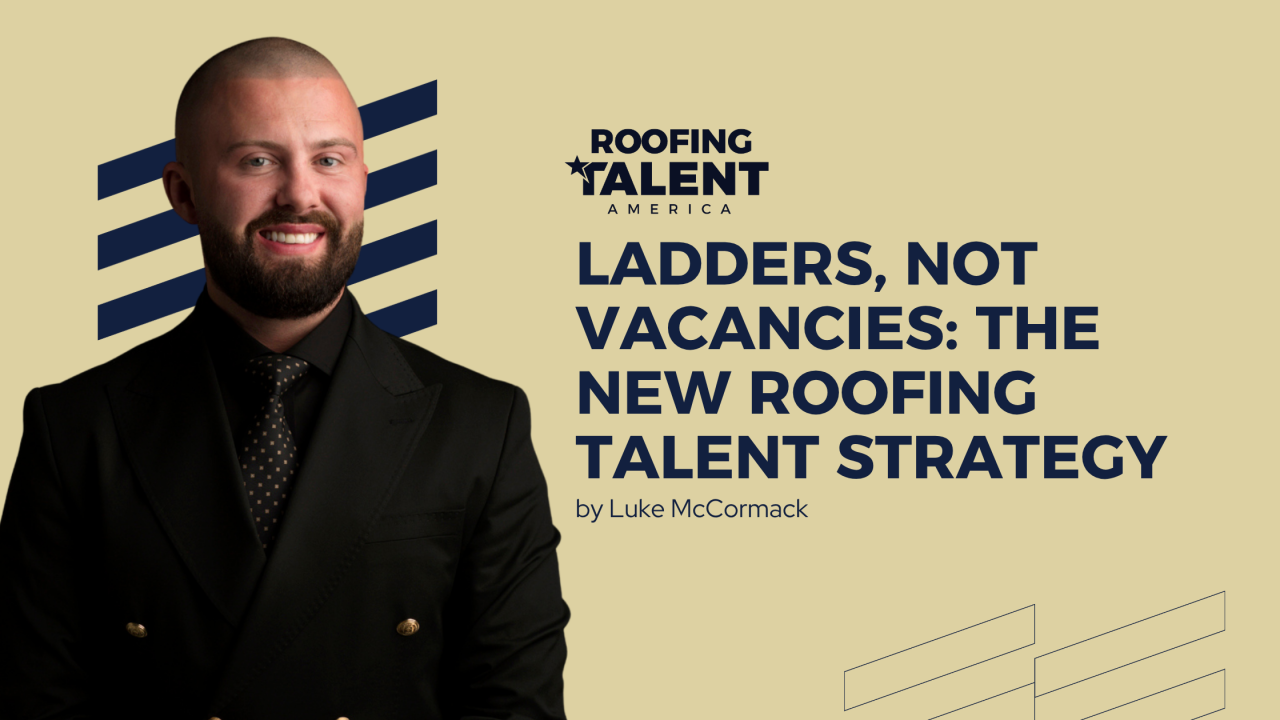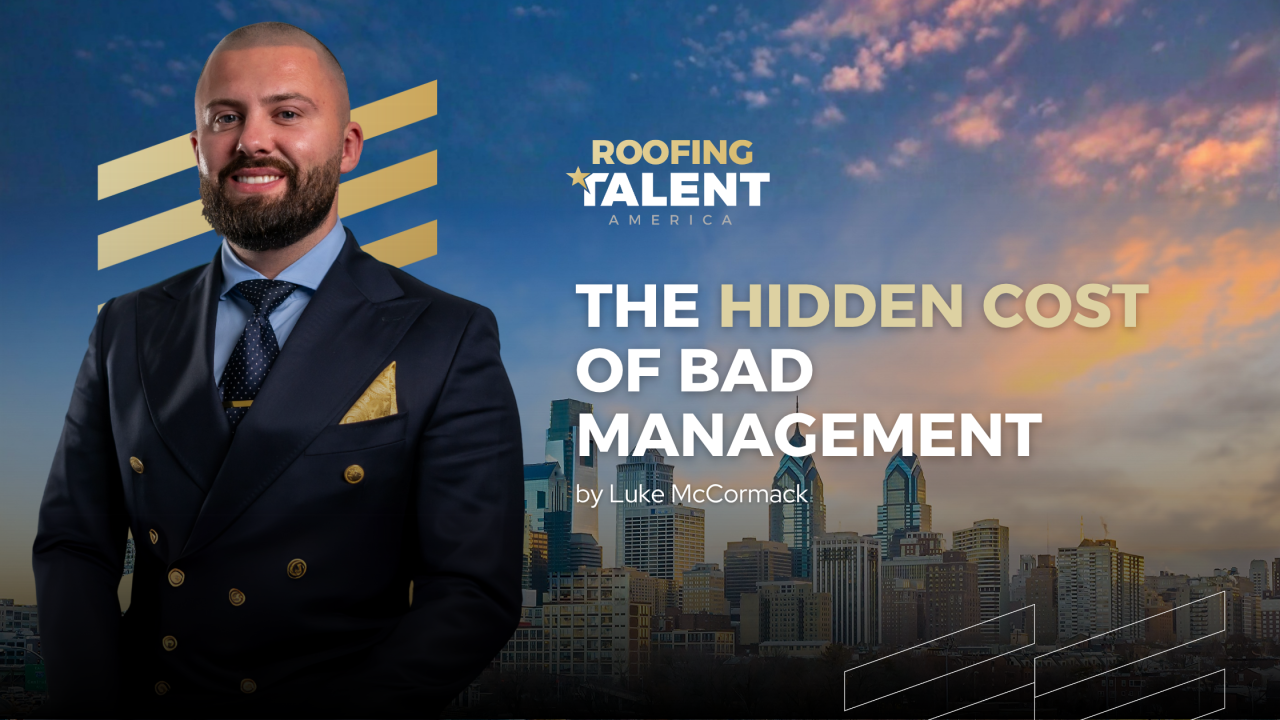Ladders, Not Vacancies: The New Roofing Talent Strategy
By Luke McCormack

Roofing’s story is changing, and the leaders shaping the next chapter are the ones putting people at the center of growth.
In our People Make Roofing conversation, I sat down with Randy Korach, CEO of Roofing Corp of America, and Ashley Aldridge, RCA’s HR Director. What followed was a masterclass on scaling a national platform without losing the soul of a local contractor.
This article distills the most useful ideas from that discussion, practical moves any roofing leader can apply.
Hire for potential. Build for progression.
Ashley didn’t grow up in roofing.
She came from branch-based facility services and brought that operating rigor into RCA. That was intentional. As Randy put it, “We valued her background, and her lack of roofing experience.” Different perspectives raise the standard.
Inside the company, that same mindset creates real mobility:
- Field to foreman to ops leadership
- Crew to safety to project management
- Apprenticeship to craft mastery to multi-branch oversight
The point: don’t just fill jobs, build ladders. Show people where they can go before they ask.
Practical move: publish 3 sample career ladders (field, operations, support) on one page. Every new hire gets it on day one.
Retention starts on the roof, not in the boardroom.
Your best recruiters are the people already wearing your logo. If they feel respected, equipped, and developed, they bring their friends and family.
That only happens when the day-to-day is right:
- Tools, PPE, and training are stocked and ready
- Pay is fair and clear
- Supervisors communicate like leaders, not traffic cops
- Wins are recognized, publicly and quickly
Randy’s example says it all: once a quarter he strapped on boots and worked a tear-off crew. Not for optics, to understand the work and show visible respect.
Practical move: run a quarterly “Field First” audit (PPE, tools, training gaps, communication flow). Close the gaps in 30 days. Tell the crew what changed, and why.
The next generation isn’t missing, they’re uninvited.
We all agree: roofing hasn’t told its story well enough. College-first narratives eclipsed the trades for a decade. That’s shifting, but it needs a push.
Roofing Corp's approach:
- Meet them where they are. Tech schools, career days, SkillsUSA, veterans’ programs.
- Show real paths. “You won’t spend your whole career on the roof, unless you want to.”
- Tell better stories. People who started on a crew and now run operations. That’s credibility.
Practical move: create a 15-minute, stage-ready talk for schools: “Three careers in roofing you didn’t know existed.” Bring a foreman, a PM, and a safety lead. Invite shadow days.
Consolidation is here. Opportunity scales with it.
Randy’s view on the industry’s future: more national platforms, more billion-dollar players, more structured development. The key is alignment. RCA won’t buy or partner unless the seller’s vision matches their people-first model.
And the risk? Leverage and centralization that cut too deep. The antidote is simple: invest in the branches and keep leadership local, with better tools, training, and options to move across a broader company.
Practical move: if you’re acquiring, publish a “What changes / What doesn’t” one-pager for teams on day one. Reduce fear. Speed trust.
Technology is changing the work, without replacing the worker.
Single-ply systems, safer methods, better planning tech, these are making the craft more technical and more sustainable. But as Randy said, tear-off and replacement won’t be automated any time soon. The job stays human, skilled, and respected.
Practical move: reframe training as upskilling, not onboarding. Track credentials. Tie pay steps to skill proof, not tenure alone.
Community is the edge no spreadsheet can manufacture.
The reason people rarely leave roofing once they’re in? Community. When leaders take care of their teams, in the shop and in life, loyalty compounds.
RCA’s partnership with FirstService includes a relief fund that supports team members during crises. That’s culture in action.
Practical move: choose one tangible support program to install this quarter (emergency fund, financial coaching, mental health access). Announce it, use it, normalize it.
What to tell the parent, teacher, or counselor asking, “Why roofing?”
- It’s visible impact. You protect the most valuable assets in a community.
- It’s durable work. Demand is steady; the skills stay with you for life.
- It’s real progression. Field to leadership isn’t a slogan here—it happens.
- It’s a tribe. You’ll find mentors, momentum, and a career—not a gig.
A simple playbook to start Monday
- Publish the ladders. Three career paths, clear steps, clear pay bands.
- Run the “Field First” audit. Fix what slows crews down.
- Turn crews into ambassadors. Referral bonuses + public recognition.
- Show up in schools. Bring stories, not brochures.
- Create one support program. Make it real and accessible.
- Measure what matters. Retention by crew, time-to-competency, internal promotions.
My takeaway: Growth at scale doesn’t require trading culture for size. Roofing Corp of America proves you can do both if you design for people first and let the numbers follow.
If you lead a roofing company and want help turning ideas like these into a hiring and retention system that actually moves the needle, let’s talk.
Our Latest





